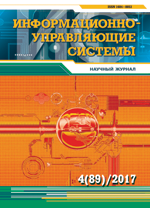Modeling the Dynamics of Nutrient Loading in Assessing the Effectiveness of Replenishment of Biological Resources
Abstract
Introduction: Sudden depletion of biological resources on the background of imaginary well-being is an important and unsolved problem. This determines the urgency of developing methods of mathematical modeling which would allow us to predict the condition of biological resources taking into account the interaction of complex environmental factors in a series of computational experiments. Purpose: We need to build complex models in order to study the population dynamics of commercial fish when the trophic status of their reservoir is changing. Methods: We synthesize discrete computer models of lake ecosystems, and a model of fish population dynamics, taking into account the peculiar life-cycle of environmental changes. This approach allows us to organize the joint use of models in our scenario experiments. Results: A complex model has been developed which binds a block describing the dynamics of nutrients influential for the generation survival when the fish ontogeny vulnerability interval is passed, with the block of population magnitude dynamics in which the above-mentioned influence is taken into account. The structure of the computational model for the generation decline dynamics on juvenile vulnerability interval is represented by a predicative redefinable system of differential equations and a system of finite difference equations describing the change in nitrogen and phosphorus concentrations, in production indicators and water transparency in their annual average. Practical relevance: The model can be applied to predict the abundance and species composition of fish population in water bodies when their trophic status is changing, and for choosing a rational strategy for the exploitation of fishing resources.Published
21-08-2017
How to Cite
Mikhailov, V., & Perevarukha, A. (2017). Modeling the Dynamics of Nutrient Loading in Assessing the Effectiveness of Replenishment of Biological Resources. Information and Control Systems, (4), 103-110. https://doi.org/10.15217/issn1684-8853.2017.4.103
Issue
Section
Control in medical and biological systems



